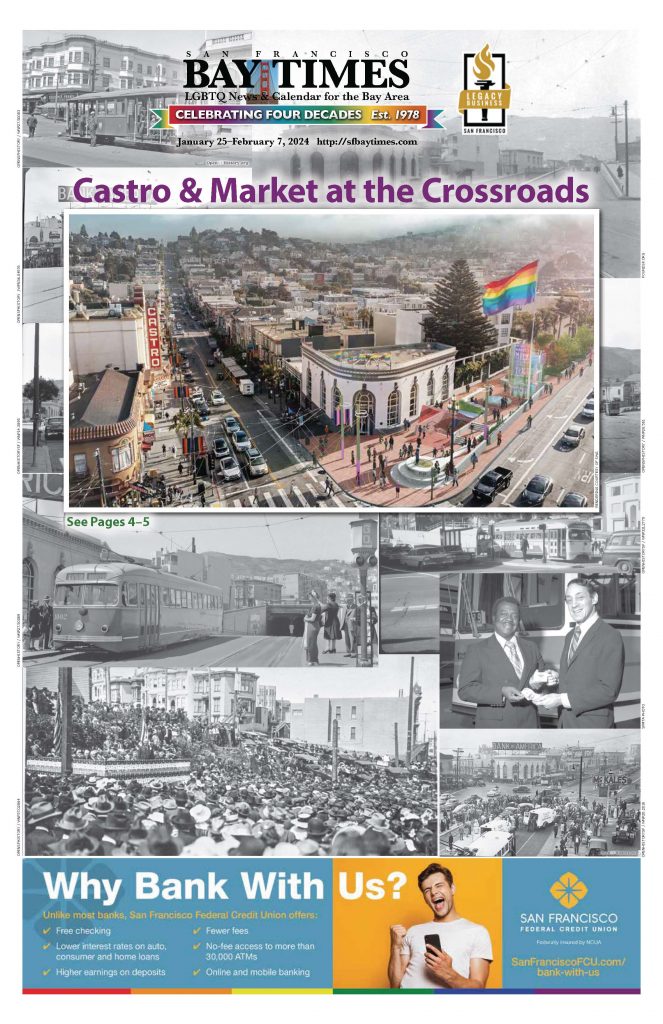
What is now Harvey Milk Plaza has served as a portal to the region for well over a century. Even before Castro Street existed—named after politician José Castro 1808–1860—working class families had already begun to settle on the slopes of Twin Peaks, with what is now Castro and Market serving as a natural crossroads.
At first Eureka Valley was primarily rural, drawing cattle and sheep ranchers as well as produce farmers, but by the 1860s there were local shops and bars. A relative of a San Francisco Bay Times team member worked as a barber in the area at this time. He would have appreciated when horsecars replaced, as the Castro Community Benefit District called them, the “smoky, noisy steam dummy cars” that ran from Market to Valencia and from there to 16th Street. Both modes of transportation were operated by The Market Street Railway Company.

An Early Independent Streak
1887 was a pivotal year for the area. That is when the company built a line linking Eureka Valley to downtown San Francisco. Since it took a while to fully connect the already developed neighborhood to the rest of the city, what would become known as the Castro District of Eureka Valley had an inherent social and commercial autonomy that would serve it well in the decades to come.
Eureka Valley, for example, was in large part spared from the overwhelming destruction that occurred throughout other parts of the city as a result of the 1906 earthquake and fire. Thanks in large part to the Golden Fire Hydrant at 3899 20th Street and those who operated it, the fire was stopped at Dolores and 20th. Since basic services were already in place in the Castro, its commercial autonomy proved to be very advantageous.
Twin Peaks Tunnel
In the years just after 1906, planning began for the 2.27-mile long Twin Peaks Tunnel that runs under the Twin Peaks that are the second and third highest mountains in the city. (Mount Davidson has the number one spot and is 928 feet high.) The project was challenging; several men died due to a cave-in and later blasting charge accident.

There was great fanfare on July 14, 1917, when the tunnel opened, including its eastern entrance that is located at the west end of the Market Street subway near the intersection of Market and Castro. The inaugural trip through the tunnel took place on New Year’s Eve, December 31, 1917. Then Mayor James Rolph served as the motorman for the first revenue trip, which took seven minutes.
Transportation and Societal Changes
When the Market Street subway—the two-level system that carries Muni Metro and BART trains under Market Street—was constructed in the early 1970s, it was connected to the Twin Peaks Tunnel. The original eastern entrance to the tunnel in the middle of Market Street at Castro was removed, however, and new entrances and ramps were constructed on the sides of the street further up the block.

All of this transportation change was echoed by social changes taking place in the neighborhood. Progressive youths, drawn to the nearby Haight-Ashbury district in the late 1960s during and just after the Summer of Love, spilled over into the Castro. The area also became a destination for LGBTQ individuals of the then most prominent gay neighborhood of San Francisco, Polk Gulch. Harvey Milk and other bright community organizers worked with the Castro’s already existing autonomy to develop a “gay mecca” that attracted still more queer individuals.
Building on Milk’s Legacy
By 1976, a design was finalized for the Castro Muni Metro subway station. Just two years later, Supervisor Milk was assassinated. While service at the station began on June 11, 1980, five years later it was dedicated to Milk. Within that window of time, regular use of the tunnel’s east portal ramps to 17th and Castro ended on September 19, 1982, with the conversion of weekend K-L-M service to light rail and the closure of the surface tracks on Market Street. (A Trolley Festival made seasonal use of the portals, but that too ended in 1987.)
In May 2016, the escalator in Harvey Milk Plaza was retrofitted with colored lights to resemble the Gilbert Baker designed rainbow flag that flies above the plaza. That same year, the SFMTA announced plans for a large project to increase accessibility to the Castro Muni Station under the plaza. The announcement led to the formation of The Friends of Harvey Milk Plaza (FHMP), a group of community members advocating for community involvement in the redesign effort. After years of work and significant public input, FHMP has developed a vision for the plaza with landscape architecture firm SWA.
Now FHMP has moved ahead into the next phase, seeking support for the newly envisioned plaza. For more information about the plans for rescheduling the event previously planned for January 25:
http://tinyurl.com/4k3zskcb
Castro & Market at the Crossroads
Published on January 25, 2024
Recent Comments